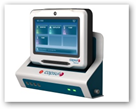Capsule Technology is an independent provider of medical device connectivity services and it sounds like this hospital has benefited from using their services. They support close to 500 devices and can be the answer to connecting devices at many different levels and age of equipment. A good  percentage of the equipment was from GE and needed to connect to a Cerner Software EHR. The cost versus going through GE was about half of the amount quoted so they saved a lot of money along the line. The “drivers” are the key to getting the hardware to work properly, as is with any computer, you need drivers and apparently this is the area of expertise Capsule decided to address a few years ago.
percentage of the equipment was from GE and needed to connect to a Cerner Software EHR. The cost versus going through GE was about half of the amount quoted so they saved a lot of money along the line. The “drivers” are the key to getting the hardware to work properly, as is with any computer, you need drivers and apparently this is the area of expertise Capsule decided to address a few years ago.
The Capsule Neuron™ can function both wired and wirelessly from the patient’s bedside. The Data Captor Software manages all the information from the devices. BD
Capsule Adds 80 Medical Devices Drivers for Software – HL7 and XML to the EHR
“Capsule’s DataCaptor™ software runs on standard Microsoft Windows based-platforms. It supports up to 500 simultaneously connected devices on a single DataCaptor™ Connectivity Server with the flexibility to link multiple systems for increased levels of scalability. DataCaptor features built-in support for over 400 bedside medical devices such as patient monitors, ventilators, infusion pumps and anesthesia machines and supports services such as data queuing and device management.”
Sherman Hospital in Elgin, Ill., wanted to integrate patient monitoring devices with its electronic health records system. However, it quickly determined that the enabling data transfer technology from its EHR vendor was not up to the task. To compound the issue, Sherman's primary medical device vendor said some older devices could not even be integrated with the EHR and suggested buying new ones at a substantial cost.
Instead, the 240-bed hospital turned to Andover, Mass.-based Capsule Technologies, a vendor that has built an interface library for more than 415 medical devices. Capsule's bedside medical device interfaces rely on device drivers that are specific to each vendor, type and version of medical device. Moreover, incorporating them into the clinical setting is a plug-and-play proposition, says Matthew Perry, R.N., a systems analyst at 240-bed Sherman Hospital. It only took a week in April 2008 to prepare some 100 devices - comprising 12 different categories - to transmit data. "The device drivers are the heart and soul of the BMDI connectivity," Perry notes.




0 comments :
Post a Comment